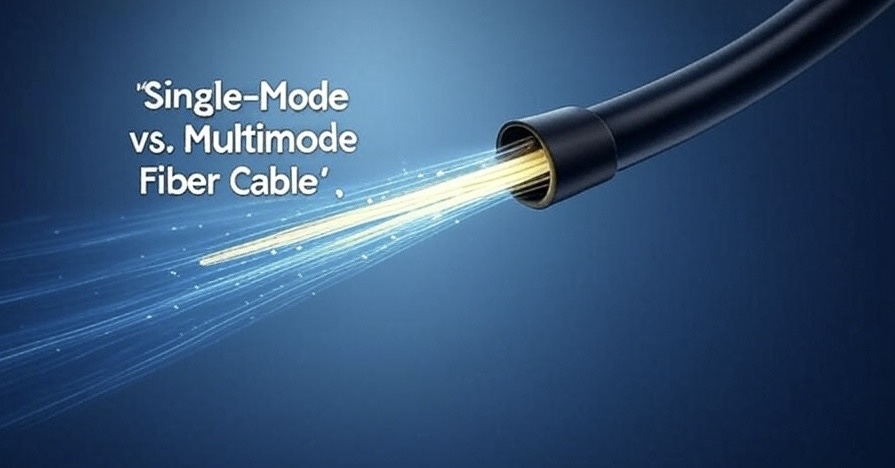Is multi-mode or single-mode fiber optics best for your network? It’s a common question, and the answer lies in understanding the core science and design differences between the technologies. The advantages and disadvantages of each will help paint a clear picture and lead you to the best choice for your specific needs. The choice hinges on a balance of performance, distance, and cost. Let’s delve into the details.
Key Takeaways
- Single-mode fiber supports long-distance, high-speed communication with minimal signal loss.
- Multi-mode fiber is cost-effective and ideal for short-range applications such as data centers and LANs.
- The decision between the two depends on distance, bandwidth, and cost constraints.
- Westward Sales offers both single-mode and multi-mode SFP modules, Ethernet switches, and media converters to support every network design.
- Reference standards like TIA-568.3-E Optical Fiber Standard and Cisco’s Fiber Optic Design Guides provide technical grounding.
Primary Design Differences Between Single- and Multi-mode Fiber
While fiber optic communication designs vary widely, they fall into two primary categories: single-mode and multi-mode. The term “mode” is the key to how they function and differ. In optics, a mode describes the path light can take as it travels through a medium.
An optical fiber is a cylindrical waveguide, typically made from low-loss materials like glass. The waveguide has a core along which light travels, which is surrounded by an outer cladding. The cladding guides the light rays through the core via a principle called total internal reflection. Light travels along the axis of the waveguide in the form of these modes. Fibers with a large core diameter can support several propagation paths for light and are called multi-mode fibers. When the core diameter is small, it only allows for a single path, making it a single-mode fiber.
Learn more: Cisco’s overview of Single-Mode vs. Multi-Mode Fiber offers a deeper dive into this concept.
Understanding Fibers
The transverse mode describes light that oscillates perpendicular to the cable’s length. Single-mode fibers only utilize light in this orientation, while multi-mode fibers can propagate light in many different modes at the same time. The diameter of a fiber allows engineers to control the modes available for light signals. Single-mode fibers must be narrow (typically only 9 microns in diameter) to limit the number of light modes. Meanwhile, multi-mode fibers must be wider (usually around 50 microns) to enable the various modes used for communication.
Because multi-mode fibers allow light to travel along multiple paths, the light rays arrive at the receiver at slightly different times, a phenomenon known as modal dispersion. This dispersion causes signal distortion over long distances, which is the primary reason for the distance limitations of multi-mode fiber. The different paths also lead to substantially more attenuation than single-mode fibers, often by an order of magnitude. In contrast, single-mode fiber has a much higher ceiling in terms of overall performance due to the absence of modal dispersion.
However, the precision required to limit a fiber to single-mode transmissions is higher, making the associated equipment more expensive. A key example is transceivers. Fiber networks utilize fiber optic transceivers, which combine transmitter and receiver circuits into a compact device. They convert data into light, allowing information to be sent and received over the network. The manufacturing process for single-mode transceivers requires incredibly tight tolerances and precise alignment of the small core diameter, which drives up their cost. There are several types of transceiver form factors; the most common type offered by Westward Sales is SFP modules.
Choosing Between the Two Fiber Options
Multi-mode and single-mode fiber optics differ significantly in performance, distance, bandwidth, and cost. Comparing the advantages and disadvantages of each is crucial for making a precise choice when designing a network and purchasing equipment.
Transmission Distance
Single-mode fiber is the undisputed champion when it comes to distance. It can transmit data over many kilometers, while multi-mode is typically limited to a few hundred meters. The modal dispersion and higher attenuation in multi-mode fibers cause performance to drop off dramatically over distance. While some multi-mode fiber can operate over distances of up to 2 km at lower speeds (e.g., Fast Ethernet), its performance at 10G+ speeds is often limited to 550 meters or less, depending on the specific fiber type (OM3, OM4, or OM5).
Learn more: See Cisco’s OM4 vs. OM5 white paper for deeper insight into multimode variations.)
Specialized single-mode fiber, on the other hand, consistently supports 10 Gb speeds at lengths of up to 10 km and can even reach hundreds of kilometers with specialized equipment. For high-speed, long-distance runs, single-mode is the only viable option. This feature makes it ideal for connecting different buildings in a campus environment or for long-haul telecommunications links.
Costs
The cost analysis between multi-mode and single-mode fiber only applies within the limits of multi-mode fiber. If a high-speed cable run exceeds 500 meters, single-mode fiber often becomes the only viable option, regardless of the cost.
The cost components of a fiber network are typically the cable itself and the SFP modules. Single-mode fiber cable is generally cheaper than multi-mode fiber cable. However, the price of a single-mode SFP module is significantly higher than that of multi-mode ones. Single-mode SFP modules cost more to manufacture because they require tight tolerances and precise alignment of a small core diameter. For high speeds, a single-mode SFP module can cost several times more than its multi-mode counterpart.
For example, a typical 10G multi-mode SFP module, like the SFP-10G-M, costs $48, whereas a comparable single-mode SFP module, such as the SFP-10G-S, is over $100. The cost difference in SFP modules is a significant factor in network design, particularly in applications that require numerous short connections.
Fiber Optic Applications
Single-mode fiber is primarily used for long-distance backbone and metro systems in telecom, datacom, and CATV networks. Its long-distance and high-bandwidth capabilities make it the perfect fit for connecting cities, countries, or even continents. Multi-mode fiber, on the other hand, is the standard for comparatively short-distance applications, such as data centers, cloud computing environments, security systems, and Local Area Networks (LANs).

Many data centers strategically build as much of their network as possible with multi-mode fiber to keep costs down. Multi-mode fiber is used for inter-rack communication, connecting servers to switches within the same room or in nearby locations. This choice is made because the distance is well within the limitations of multi-mode fiber, and the cost savings on SFP modules are substantial. While single-mode fiber offers superior speed and transmission distance capabilities, its higher cost makes it less practical for widespread use within a single data center building. Single-mode fiber is standard for connecting buildings or long-distance external links.
Learn more: See TIA 942-B data center standards and the Fiber Optic Association’s standards guide for supporting references.)
Need Help Choosing the Right Fiber Optic Solution?
Navigating the complexities of single-mode and multi-mode fiber optics can be challenging, but you don’t have to do it alone. Westward Sales would love to help you find the best fiber optic solutions for your project. We offer a large variety of Ethernet switches, media converters, and SFP modules to suit any network design. Speak with a sales representative today to learn more about our fiber devices and receive expert guidance tailored to your specific needs. Contact us to build a more efficient and cost-effective network today!
Frequently Asked Questions
Single-mode fiber uses a narrow core (~9 µm) that carries one light path for long-distance, high-speed communication. Multi-mode fiber has a larger core (~50 µm) allowing multiple light paths, ideal for short runs like LANs and data centers.
Single-mode fiber is best for long distances, supporting speeds of 10 Gb or higher over 10 km or more. Its low dispersion and attenuation make it the preferred choice for backbone and metropolitan networks.
Yes. Multi-mode fiber and its related transceivers are typically more affordable and easier to install, making them cost-effective for in-building and short-range connections.
Not directly. The two types have incompatible core sizes and transceiver requirements. To connect them, use a media converter to bridge the signal types safely.
If you need to connect devices within a single building, multi-mode is cost-effective. For longer distances, or if future bandwidth upgrades are likely, single-mode provides better long-term scalability. You can always contact Westward Sales for expert recommendations.

Leave a Reply